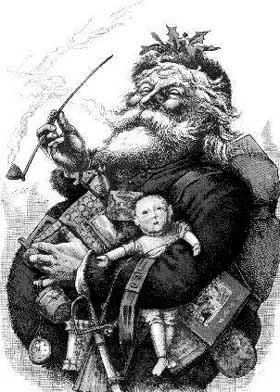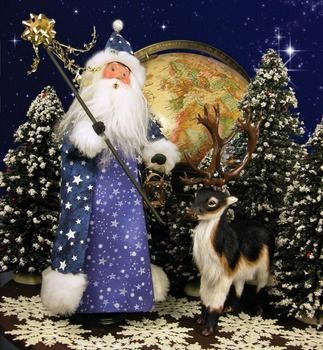 Thank God its FFF. This is the last Friday before Christmas so I thought if I'm going to do a Christmas theme I have to do it now. One thing that ha always fascinated me is the history of Santa Claus. What I find most interesting is the shadowy forerunners of Santa, those folkloric figures from the mists of Europe's past that form the basis of the Santa Claus legend. That is what I will most concern myself with here. But of course I would be remiss in not discussing the historical making of the modern Santa Claus. Our modern North pole dwelling Coca Cola guzzling Santa has only been around since the late 19th century, and was formed out of developments that began to take shape right after the American revolution.(St. Nicholas Center)
Thank God its FFF. This is the last Friday before Christmas so I thought if I'm going to do a Christmas theme I have to do it now. One thing that ha always fascinated me is the history of Santa Claus. What I find most interesting is the shadowy forerunners of Santa, those folkloric figures from the mists of Europe's past that form the basis of the Santa Claus legend. That is what I will most concern myself with here. But of course I would be remiss in not discussing the historical making of the modern Santa Claus. Our modern North pole dwelling Coca Cola guzzling Santa has only been around since the late 19th century, and was formed out of developments that began to take shape right after the American revolution.(St. Nicholas Center)Before that time Christmas wasn't much celebrated in America. We had it but it was not regarded. Of course the Colonists had the tradition of Father Christmas from England. Around the time of the American revolution Christmas had fallen into disfavor because he was English. The American fascination withy Santa Claus comes from The Dutch who had settled New York. The Dutch had a forerunner Claus, Sinterklaas. That name means Saint Nicholas but I'll get to him in a bit. Our term "Santa Claus" derives from this Dutch name. It Washington Irving (1783-1859:"The Legend of Sleepy Hollow"-Headless horseman and all) who first made Santa Claus popular in America.
Diedrich Knickerbocker, Irving wrote the satirical A History of New York from the Beginning of the World to the End of the Dutch Dynasty. Irving dedicates his satirical "history" to the New-York Historical Society, and makes dozens of references to an impish, pipe-smoking Saint Nicholas who brings gifts down chimneys, thus beginning a legend that will travel round the world. That it was published on St. Nicholas's feast day, December 6, 1809, was no accident.("Father of Christmas")Irving's Modus Oporandi was to draw upon the folk traditions of New York Dutch that had been forgotten by most New Yorkers and that dipped way back into the fount of Northland folklore from the old country. His Santa road a horse there were no reindeer he did not live at the north Pole. I do not know if the Horse was Irving's idea but I think going down the chimney was already a Dutch idea. Yet Father Christmas didn't that. Dutch children were given candy and nuts in their shoes not stockings, they ere left on window ledges and the foot of the bed not hung from the fireplace. Two other figures were important in the making of modern Santa, John Nast the great political Cartoonist, that's a Nast Claus at the top.
1821 brought some new elements with publication of the first lithographed book in America, the Children's Friend. This "Santa Claus" arrived from the North in a sleigh with a flying reindeer. The anonymous poem and illustrations proved pivotal in shifting imagery away from a saintly bishop. Santa Claus fit a didactic mode, rewarding good behavior and punishing bad, leaving a "long, black birchen rod. (St. Nicholas Center, op.cit.)Following that in 1823 Clement Moore's poem "A Visit from St. Nicholas" (aka "The Night Before Christmas"). That poem added the names of the reindeer. One interesting fact was the gesture he makes to go back up the chimney, putting his finger beside his nose. This gesture is recorded by Irving in his story and that same gesture was the Dutch way of winking when telling a tall tale or some story you know is just a yarn. From there the next big sr5eppw were 20 the century: Rudolph and Coke.
Saint Nicholas
The story of Santa Claus really begins with St. Nicholas who was a real historical man, although not much is known about him. We know he lived in
the Bishop of Myra (in present day Turkey) in the early fourth century, who was known for helping the poor and giving presents to children. In the Middle Ages, Christians celebrated his feast day, Dec. 6, by leaving gifts for children in their shoes.(finding Dulcinea: Christmas).He was born around 280. No one knows when he died. He was supposedly wealthy and spent his family fortune helping the poor. He became so popular as a champion of children that for centuries he was as famous and as legendary as our Santa and he was the yearly gift giver spreading through Europe. His feast day was on December 6th that used to be the toy giving day. St. Nicholas was the toy giver.(History Channel "Santa Claus")

Shadows in the mists of time
Many of these treatments of Santa history begin with St. Nicholas but there were gift givers before him. The figures became the basis for the legend of gift giving Nicholas. They only hint at trace of forgotten times and cultures.
In Scandinavia the Norse God Odin acted as annual gift giver for children. He would fly around on his eight legged steed giving gifts. Children left their boots by the Chimney for Odin; who was associated with the Solstus thus linking him to December 25. The Germanic people had another gift given Frau Holda, winter.(Santa Claus' Pagan Origins). These two date to 13th century so they don't pre date St. Nicholas. In Italy we have Le Befanna who was said to have misled the wise men as they sought the Christ child. She went to find them to put it right but could not, thus wonders the giving gifts to children so as not to miss the Christ child, she too is 13th century. (Ibid).
In pre Christian times Germanic people and English celebrated mid winter festival of Yuletide. Many aspects of this tradition were absorbed into Christmas. This is where all the holy and Ivy stuff comes from. Father Christmas probably traces to that period, even though the first written sources are 15th century (Orchard, Andy (1997). Dictionary of Norse Mythology and Legend, page 187. Cassell). Likewise Odin is pre Christian ads sa god and probably as a gift giver as well, but our written sources begin in 13th century."The appearance of Santa Claus or Father Christmas, whose day is 25th of December, owes much to Odin, the old blue-hooded, cloaked, white-bearded Gift bringer of the north, who rode the midwinter sky on his eight-footed steed Sleipnir, visiting his people with gifts. … Odin, transformed into Father Christmas, then Santa Claus, prospered with St Nicholas and the Christchild became a leading player on the Christmas stage."(Baker, Margaret (2007 1962). Discovering Christmas Customs and Folklore: A Guide to Seasonal Rites Throughout the World, page 62. Osprey Publishing).

Polish Starman
Poland has a Pre Nicholas Santa figure called "Satarman." "In some regions of Poland, at the end of supper, Father Christmas, known as The Starman (very often the parish priest in disguise), accompanied by singing Starboys, pays a visit. He brings rewards to good children from Starland, and scolds the naughty ones, who eventually get their reward, too." (Polish Christmas). Starman is not jovial figure, no Ho ho ho, He first threatens to beat the children and then relents. Then he passes out presents.
In Russiia Father front and his grand daughrt are Clauslike gift givers but they fdon't pre date Nicholas. There is onewho does. Nicholas as gict giver in Ruwi is patterend after an older figure.
Ded Moroz or Father Frost, the Slavic version of Santa Claus, long ago became the symbol of Russian winter, New Year’s and presents. He is usually accompanied by his granddaughter Snegurochka riding with an evergreen tree in a traditional Russian troika, a sleigh drawn by three horses abreast.Snegurochka is a unique attribute of the image of Ded Moroz – none of his foreign colleagues have such a cute companion.The original Russian gift-giver was Saint Nicholas, the country's Patron Saint, whose Feast Day is celebrated on December 6th. The image of Saint Nicholas originates from the image of another hero – the ancient Morozko. In Russian folklore Morozko is a powerful hero and smith who chains water with his “iron” frosts. Morozko was not hostile to people - he helped them and presented them with awesome presents.In fairy tales Morozko is at times kind and at times evil. To be precise, he is kind towards the hard working and the good-hearted, but extremely severe with the mean and the lazy. And it is not about justice only. It is rather about two personalities living in one magical person.(Russiapesia).The anti Santa
Even our modern Santa has his negative side. In my parents generation they would say that he would bring coal to bad children. Then it evolved to just a passive 'no gifts' for bad children. We have seen that older figures have more negativity. Starman is austere and threatens punishment although he's really a pushover. Even t5he Russian figure older than Nicholas is schizophrenic. There I an even older figure who hints at a forgotten past now very foreign. This is an actual evil figu8re2who balances Santa called "Krumpus." He's in the Bavarian Alps. He has a demonic face and horns, sound familiar? (Republican Candidate)?
In Austro-Bavarian Alpine folklore, Krampus is a horned, anthropomorphic figure who, during the Christmas season, punishes children who have misbehaved, in contrast with Saint Nicholas, who rewards the well-behaved with gifts. Regions in Austria feature similar figures and, more widely, Krampus is one of a number of Companions of Saint Nicholas in regions of Europe. The origin of the figure is unclear; some folklorists and anthropologists have postulated a pre-Christian origin for the figure.( wiki Author sites:Crimmins, Peter (15 December 2011). "Horror For The Holidays: Meet The Anti-Santa". NPR. Retrieved 25 November 2015).There are other such figures in surrounding areas. This is really ancient and moving back into the mists in a time we know little about. (Haid, Oliver (2006). "Christmas markets in the Tyrolean Alps: Representing regional traditions in a newly created world of Christmas". In David Picard, Mike Robinson. Festivals, tourism and social change: remaking worlds. Buffalo, New York: Channel View Publications. pp. 216–19. ISBN 978-1-84541-048-3).

4 comments:
Thanks for the fascinating information! There is another meaning of laying a finger aside of one's nose-- in Clement Moore's day it often meant, "You and I are in the know." Also see Danny Kay's song in "The Inspector General" where he uses the finger-aside-the-nose to mean, "I'm wise; I have knowledge others lack."
In Moore's poem, I believe Santa was saying to the observer, "This is our secret. Let's keep it quiet."
I didn't know about the pre-Christian origins of Santa. Very interesting!
pretty sharp. Thanks Kristen.
Merry Krampus, everyone! ;)
LOL thanks Mike!
Post a Comment